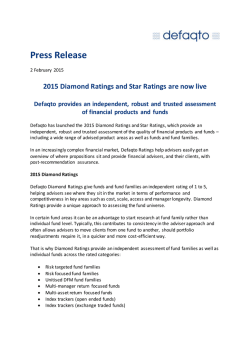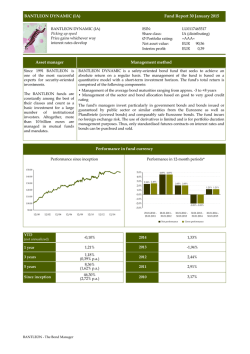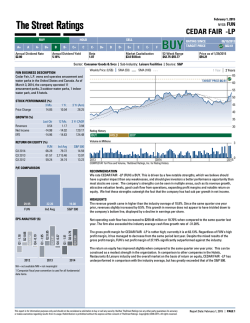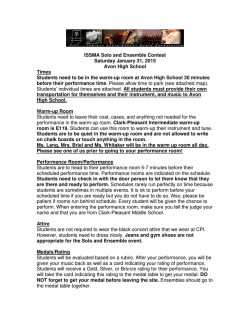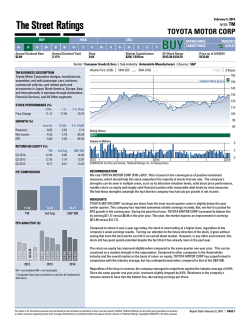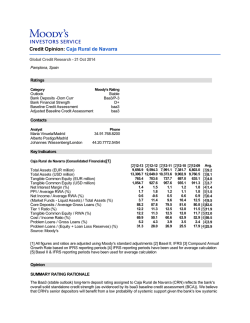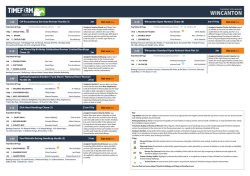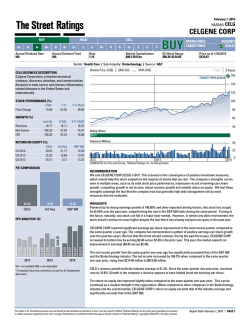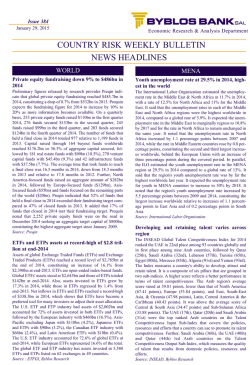
Performance Management - Society for Human Resource
SHRM-SIOP Science of HR White Paper Series Putting the “Performance” Back in Performance Management Rose A. Mueller-Hanson, PDRI, a CEB company & Elaine D. Pulakos, PDRI, a CEB company Copyright 2015 Society for Human Resource Management and Society for Industrial and Organizational Psychology Rose A. Mueller Hanson, Ph.D. CEB Senior Director [email protected] 703-276-4680 For over 15 years, Rose has dedicated her career to helping improve individual and organizational performance through better talent management. In her current role at PDRI she leads the Performance Impact Solutions Consulting Division. A strong advocate for creating more effective and engaging approaches to performance management, she is the co-author of several recent articles on the topic, including Building a High Performance Culture: A Fresh Look at Performance Management, published by the Society for Human Resources Management Foundation. Rose is a corecipient of the M. Scott Myers Award for Applied Research in the Workplace (with colleagues from PDRI), awarded by the Society for Industrial and Organizational Psychology (SIOP). In 2014, she was elected a Fellow in SIOP. Prior to joining PDRI in 2002, she worked as a human resources manager and served in the U.S. Air Force. Elaine Pulakos, Ph.D. CEB Executive Director/PDRI President [email protected] 703-276-4680 Elaine has spent her career working with organizations to design and implement talent management systems. She has authored numerous articles, book chapters, and books, as well as three best-practice volumes for the Society for Human Resources Management (SHRM) on performance management, driving a high performance culture, and staffing. Most recently, her work has focused on performance management reform and specifically gaining more value and ROI from performance management processes. She has written two recent articles that have been influential in fundamentally shifting how performance management is designed and executed in organizations – in 2011, “Why is performance so broken?” and, in 2014, “Performance management can be fixed.” Elaine’s work has been recognized with several awards, including the Society for Industrial and Organizational Psychology’s (SIOP) Distinguished Professional Contributions Award. ABSTRACT Dissatisfaction with traditional performance management is on the rise, leading many organizations to seek ways to improve their approach to managing performance. Traditional performance management processes, however, are often perceived as burdensome, demotivating, and without value. In this paper, we provide evidence-based, practical approaches for improving performance management. Suggestions include improving goalsetting to make it more flexible and responsive, providing more effective performance feedback by making it part of everyday work instead of only delivered once or twice a year, and refining the annual performance review process to make it more forward-looking. A key theme in these recommendations is to link key elements of the performance management process to align with and support organizational objectives. Putting the “Performance” Back in Performance Management Despite years of research and practice, dissatisfaction with performance management (PM) is at an all-time high. More than 75 percent of managers, employees and heads of HR feel that PM results are ineffective and/or inaccurate (CEB Corporate Leadership Council, 2012). Additionally, study after study has shown that the performance review is dreaded – it is not only perceived to be of little value but it is highly demotivating to employees, even the highest performers (Culbertson, Henning, & Payne, 2013; Rock, 2008). Between formal goal-setting processes, mid-year and yearend reviews, and often extensive rating and calibration processes, a great deal of time and effort is expended on PM activities, costing organizations millions annually with questionable returns. For example, recent research has shown that PM ratings are not accurate predictors of actual business performance – that is, PM ratings have zero correlation with business unit performance (CEB Corporate Leadership Council, 2012). Pulakos and O’Leary (2011) offered a comprehensive analysis of why traditional PM approaches fail to live up to their promise of impacting individual and 1 organizational performance. Their key insight was that the mechanics of the appraisal process – for instance, how ratings are done, the type of documentation required, how goals are set – are not effectively designed to impact performance. This is largely because formal PM activities occur on a prescribed schedule, intermittently throughout the year instead of occurring in real time when outstanding performance is observed or course corrections are needed. These authors further argued that open communications and good relationships between managers and employees that enable ongoing, informal feedback and agile goal-setting have much more impact on increasing performance effectiveness than formal PM system steps and processes. In fact, research has shown that unlike formal PM processes, effective PM behaviors such as providing informal feedback, setting clear expectations, and working collaboratively with employees to solve problems have significant impacts on driving organizational performance (CEB Corporate Leadership Council, 2004). Dissatisfaction with PM has recently come to a head, as organizations have experienced increased frustration from managers and employees regarding formal PM processes. This has generated considerable debate concerning how PM can and should be changed to add more value. The importance of effective PM behavior has been recognized and several organizations have begun changing aspects of their formal PM approaches with the hope of driving more effective PM behavior (e.g., real time feedback, more agile expectation setting and goals, more collaboration). Several highprofile companies, including Microsoft and Adobe, have made radical changes to their formal PM processes, such as eliminating performance ratings altogether. However, 2 the majority of companies that are making changes are taking more measured steps, such as introducing flexible goal-setting and more frequent performance check-ins to drive more regular expectation setting and feedback. Given the sense of urgency to “fix” PM, organizations are seeking answers about how to change their PM processes to increase value and reduce burden. In an ideal world, if all managers and employees consistently engaged in effective day-to-day PM behavior, there in fact should be no need for a formal PM process. However, not all and perhaps not even most managers regularly engage in effective PM behavior. Although one option is to abandon formal PM entirely, most organizations are not in a position to consider such an extreme step. Many organizations also feel that they need evaluations of record for legal or other purposes. We will not argue the merits of keeping or abandoning formal PM approaches here but rather we will focus on answering what is practically the more important question, namely: How can organizations best design their PM approaches to add value, reinforce key behaviors, and avoid the negative consequences so often observed? We begin our discussion with the importance of defining the PM purpose and aligning it to business objectives. We then provide research and evidence-based recommendations for designing a PM process that provides a structure in which there is room for positive PM behavior to occur. We close with a discussion of actions that organizations can consider to improve the value of their PM approaches today. 3 PM Purpose Over the years, there have been many PM approaches and fads that have been implemented in the hope of improving the quality and value of the PM process, including different types of goal-setting processes; rating forms, types, and scales; different raters; various documentation requirements; and other methods. Organizations have implemented many of these “flavor of the day” PM approaches but without always asking what purpose they wanted to achieve most with their PM process and whether or not it was achieving these goals. In delivering dozens of workshops on this topic, we always begin by asking the question, “What is PM used for in your organization?” The top answers include: Make decisions about pay, promotions, or other personnel actions. Identify poor performers and hold them accountable. Provide documentation to defend against legal challenges. We next ask, “What would you like PM to accomplish ideally for your organization?” The answers to this question are much more aspirational: Help employees develop and grow. Improve communication between employees and managers. Align individual work to achieving the organization’s goals. Help individuals and teams perform to their highest potential. When asked to reflect on the differences between these two lists, participants always note that the first list relates to administrative purposes while the second list reflects the desire for performance management to actually increase individual and 4 organizational performance. Unfortunately, participants often then observe, with dismay, that their PM approaches actually don’t achieve either their administrative or aspirational goals well. PM approaches that try to serve too many purposes will not serve any purpose well. An example is using a single set of ratings to give raises and bonuses, make promotion decisions, make layoff decisions, identify development needs, motivate high performers, and a host of other actions. Different types of decisions require different criteria. For example, an employee’s annual merit increase is usually based on several factors such as the organization’s budget, changes in the labor market for the employee’s specific job, where the employee falls in the salary curve relative to her peers, and performance. In contrast, a decision about whom to promote is based on not only Many organizations seeking to improve their PM approaches will performance but also demonstrated potential to operate successfully at the next level. These two very different actions require different decisions start with questions such as “should we have ratings?” or, “should we use a forced distribution, and if so what processes and criteria. It is unrealistic to expect one process to inform both decisions well, let alone the myriad of others that organizations should the cutoff percentage be for the lowest rating?” This is the wrong place to start. The right question to start with is: What often use PM to support. The concept of performance management is squarely aimed at helping the organization outcomes are critical for the organization to achieve, and how can we best ensure employees deliver these outcomes? maximize its productivity through enabling 5 employees to perform to their potential. To achieve this, performance should be managed to accomplish three critical goals: Enable employees to align their efforts in a manner that contributes most to the organization’s goals. Equip employees with guideposts to monitor behavior and results and make adjustments in real time as needed to maximize performance. Help employees remove barriers to performance. Each aspect of the PM process should be designed to efficiently and directly impact one or more of the above goals. In the next section, we explore traditional PM process steps in light of these objectives. The PM Process There are three main components to most PM processes: setting performance goals, monitoring progress, and evaluating results. Unfortunately, over time, PM processes have become increasingly over-engineered to the point that they have taken on a life of their own. Managers and employees alike complain that they spend an inordinate amount of time on PM documentation, forms and other administrative tasks that have nothing to do with managing performance. This has rightly caused questions about the value of these activities and conclusions that there is little. Negative perceptions about PM are often exacerbated by automated systems with rigid workflows that require numerous handoffs and approvals in order to complete each step in the process. In the following sections, we discuss how each of the three primary 6 PM activities is accomplished and offer alternatives for how they can be accomplished more informally and efficiently, providing leeway for more effective PM behaviors. Setting performance goals Goal setting is one of the most powerful ways to direct energy and focus and improve performance, and it is no wonder it is at the heart of most PM processes. Years of research on goal setting have identified how to set goals so that they are powerful drivers of performance. According to Lock and Latham’s seminal work, goals work best when they are challenging and meaningful to the individual (Locke & Latham, 1990). Unfortunately, when goals are used as part of a formal PM approach, organizations typically put practices in place that undermine the very characteristics that make goals so powerful. Setting performance goals typically entails two processes: cascading goals and setting SMART (Specific, Measurable, Achievable, Realistic, and Time-bound) individual goals – both of which typically occur on an annual basis. While these practices are purported to be grounded in best practice and research, they rarely, if ever, work as intended. Cascading goals are used to ensure line of sight between highlevel organizational objectives and individual work. To cascade goals, each organizational unit is required to set its own goals based on the unit above it, as illustrated by the left side of Figure 1. In turn, individual employees have goals that flow down from their unit goals. 7 Figure 1: Cascading Versus Linking Up Typical Approach: Top-Down Cascade New Approach: Linking Up Org Division Group Team Individual There are two major challenges with cascading goals. First, because this process is sequential, it is incredibly time-consuming. Organizational units cannot set their goals until the level above them has set theirs. In complex organizations with many layers, the entire cascade can take months, leaving many individuals without performance goals for a significant time. Indeed, in the organizations in which we have worked, most have experienced “broken links” in the chain whereby several groups are left without goals because somewhere along the line a unit did not do its part of the cascade in a timely manner. The second problem is that with so many translations of 8 the original goal, by the time the cascade reaches individual employees, the relationship to organizational objectives and even to their own jobs can be murky at best. Cascading is like the game of “telephone” in which the multiple retellings of a story alter it, such that the story often morphs into something different than was intended with the original goal. Fortunately, there is a better alternative to cascading goals: “linking up,” as shown in Figure 1. Instead of cascading down, each unit and employee sets their own goals by “linking up” to the organization’s objectives. This avoids having to wait for each level above to complete its cascade, and each team and individual can set goals simultaneously. This approach is not only much faster than traditional cascades, but it also allows for a more direct line of sight between an individual’s goals and the organization’s objectives. Moreover, it typically results in more meaningful and clearer goals, which is especially useful within more complex organizational structures. Now we turn to the other challenging goal setting practice, SMART goals, whose achievement, or lack thereof, often provides the basis for performance ratings. There are three challenges associated with the use of SMART goals. First, the work environment today changes too rapidly to set goals only once per year. To remain current, relevant and impactful, goals need to be updated as situations change, which almost never occurs in practice and can render goals outdated soon after they are set. Moreover, a year is too long of a time horizon to motivate action. It is difficult to set goals with sufficient specificity that cover an entire year for most jobs; in fact, different jobs require goals with different time horizons. For example, call center employees may 9 have daily goals for the number of calls that need to be processed, while a researcher in an R&D function may have multi-year goals with somewhat flexible milestones. Applying a one-size-fits-all rule for goal setting simply does not work well for everyone in most organizations. Second, when goals are used as the basis for performance ratings, they are rarely challenging enough. Goals work best when they are difficult – not so difficult that they can’t be attained but difficult enough that employees are challenged to meet them. If meeting one’s goals only results in a rating of “meets expectations” (or a rating of “three” on a five-point scale), employees and managers often write goals that can easily be exceeded, enabling employees to earn a higher rating. Third, effective use of SMART criteria can Effective Examples of Goals actually reduce differentiation among employees, which is something most traditional PM processes advertising the new product. callbacks for the same provided. However, the more specific and employees will achieve their goals. This is because goals that provide specific details about what success looks like and how success will be measured remove ambiguity and help everyone perform Handle at least XX service calls per day with fewer than Y aim to drive so that differential rewards can be measurable the goal, the more likely it is that By X date launch the web page problem. Enhance division visibility by: - Publishing an article on X topic by Y date. - Publicizing our upcoming event on a variety of social media outlets, resulting in XX registrations on our website. better (e.g., Locke, Chah, Harrison, & Lustgarten, 10 1989). Therefore, specific goals can help raise the performance level of all members of a group, but they may be less useful as the basis for making distinctions among individuals, if the basis of one’s rating is goal attainment. Unfortunately, as mentioned above, goals in a performance evaluation context are often set at a level that enables them to be easily achieved, if not exceeded. This undermines realizing the motivating and high performance potential that more challenging goals can drive. Research has shown that goals set in learning contexts tend to be more challenging than those set in performance contexts – the former leading to higher performance, especially with more difficult tasks (Winters & Latham, 1996). What to do instead. Given the challenges associated with the use of goal setting in traditional PM processes, organizations may be tempted to abandon this practice altogether. In our own work of examining thousands of goals across a variety However, goal setting has many benefits and having of organizations, we have found goals can lead to higher performance. Therefore, we that there is often an over- recommend using goal setting but differently than it emphasis on making sure that performance goals adhere to is used in most formal PM processes: “SMART” criteria at the expense of being meaningful and driving Employees and managers should collaborate in setting no more than three to five performance performance increases. As a result, organizations often spend a goals that clearly relate to the organization’s significant amount of time and priorities. Goals should be brief and include only money on training employees and the most important results the employee is expected to achieve. managers to develop SMART goals without realizing any improvement in performance. 11 Base the timeframe for these goals on what is relevant to the job. That is, what is the time horizon for which the employee and manager have line of sight? When in doubt, quarterly goals can be a good rule of thumb because three months is enough time to accomplish a significant result, and setting goals that can be achieved or revised each quarter is not onerous if the process is streamlined. Instead of slavishly adhering to SMART criteria, strive for meaningful goals. While some jobs lend themselves to quantitative metrics, measures of success in other jobs are more subjective. Don’t get so wrapped up in making sure goals are SMART that you lose sight of what’s most important for employees to accomplish. Ensure goals are sufficiently challenging. A successful goal is one that will push employees outside of their comfort zones so that they must put forth a great deal of effort to achieve them. Meeting the goal should be a significant and meaningful accomplishment. Ensure the linkages between goals and rewards make sense for the work. For example, for jobs in which results are easily quantifiable and under the employee’s direct control, rewards directly tied to goals can work well. However, for more complex jobs in which results are difficult to quantify or things outside the employee’s control can get in the way, the extent to which goal attainment is tied to rewards should remain a judgment call. Consider incentivizing the extent to which the employee or team takes on challenging (but achievable) goals and makes positive progress towards achieving them, rather than goal attainment per se, as the former will lead to higher performance overall. 12 Monitoring progress Many organizations require performance check-ins once or more during the year. The intent of these meetings is to provide feedback in between goal setting and performance evaluation. It’s an opportunity to check progress and ensure the employee has feedback and a chance to course-correct before the end of year rating. The level of formality with these check-ins varies by organization. In some, a simple conversation is all that’s required. In others, the process is almost as formal as the end of year review and includes a written self-assessment, supervisor ratings, a written narrative, and a performance conversation. Organizations that require a more formal process at mid-year do so because they believe it is important for accountability and to ensure the conversation actually takes place. Also, it’s a way to flag and correct performance problems before the formal ratings at the end of the year. Unfortunately, formal mid-year review policies often arise from a fundamental mistrust that managers left to their own devices will choose to do the wrong thing and not provide any feedback to employees. The premise of the mid-year review makes sense on the surface – provide a mechanism for employees to get feedback more than once a year. However, in practice the mid-year review falls short for many reasons: 13 Getting feedback once or twice a year is too infrequent to impact behavior and performance. The formalized process that many organizations use places additional burden and time demands on employees and managers without any improvements in performance. Managers may avoid giving feedback on a Contrasting Traditional Feedback with Teachable Moments more regular basis because they mistakenly believe that feedback should be given during formal check-ins only. Traditional Feedback: “At the last staff meeting, you did a nice job of setting the agenda and kicking A formal mid-year review is often as things off. However, you didn’t perfunctory as the end of year review, with engage the quieter members of the neither managers nor employees finding the group and you let Sam dominate the conversation.” process valuable. Formal and informal mid-year reviews reinforce the view of feedback as backward Teachable Moment: “Let’s discuss how that meeting went. What did you think went well? I agree the looking and evaluative; current neuroscience agenda was very clear – any research shows that approach to feedback lessons learned that will help you causes employees to become defensive and continue this habit in future? What would you do differently the next even high performers may perform worse time? I agree Sam seemed to after this kind of feedback conversation dominate the conversation. What (Rock, 2008). techniques will you try next time to keep things more balanced?” What to do instead. We suggest making 14 the performance monitoring process informal and driving it to become an ongoing habit that is embedded in the organization’s culture. Both managers and employees need to be trained to check in more frequently to clarify expectations and provide feedback – this needs to become part of their ongoing work – not a separate conversation. By training, it’s important to move beyond simple skill building and instead provide guidance and structure that helps people practice and solidify these behaviors in the context of day-to-day work. Critical steps in this process include: At the beginning of each task or assignment, ensure expectations are clear. Both managers and employees need to learn how to do this well. As work becomes more interdependent, it is not only managers that need to assign work effectively, all employees need to know how to make an effective and complete request and to clarify requests when needed. As work progresses, be intentional about giving ongoing praise and acknowledgement for what is going well. This not only motivates higher performance, it reinforces the right behaviors and outcomes. Provide coaching in the moment or as soon as possible after an event. Treat the event as a teachable moment. The goal is to promote learning and awareness of how to improve. To leverage a teachable moment, don’t spend a lot of time discussing what went wrong. Use the opportunity to discuss what could be done differently in future. Focus on the process instead of the outcome. Coaching is more acceptable when it is focused on process because it provides a way for people to understand how to improve and not just what to improve. 15 Driving clear expectations, informal feedback, and assistance in solving problems as needed throughout the organization will have a much higher impact on increasing performance than any formal PM step. Evaluating results Traditional PM approaches typically include a formal end-of-year evaluation with a written self-assessment and a supervisory assessment. The assessments often include numerical ratings on competencies, performance objectives, or both, plus a narrative description of the performance. The written documentation is usually followed by a conversation to review the evaluation information after which the form is signed and retained for recordkeeping purposes. The extent of documentation required varies widely by organization. We have seen simplified rating approaches that call for one overall summary rating and narrative statement. We have also seen extraordinarily complex rating approaches that include individual ratings on three to six objectives plus six to 12 competencies, with narrative descriptions required for each plus an overall narrative statement. Rating scales also vary, but the most common in our experience is a five-point scale, with a “three” being an average or “meets expectations” rating. The purpose for this traditional approach is rooted in several long-standing assumptions. However, most of these assumptions are not supported by the research. Table 1 provides a comparison of common PM assumptions and the realities. 16 Table 1. Assumptions and Realities about Performance Ratings Assumptions More rigorous ratings will provide better data upon which to make effective decisions. Realities Most performance ratings are not accurate reflections of objective performance. Managers have a number of competing interests and constraints unrelated to an employee’s actual performance that influence ratings (e.g., Murphy & Cleveland, 1995). Moreover, studies have found the correlation between performance ratings and business results is zero (CEB Corporate Leadership Council, 2012). Therefore, ratings are typically a flawed basis for decision making. Employees need to know “where they stand” so that they have a realistic view of their performance. Most employees believe they are above average performers. In fact, people generally believe they are above average on nearly any attribute from driving to attractiveness. Therefore, a rating system that accurately labels the majority of employees as average or at the middle of any rating scale will be inherently demotivating to most people. Employees need to know where they stand on decisions that affect them. However, using a label such as “meets expectations” is an indirect way of communicating that tends to frustrate more than inform. Making distinctions with ratings is motivating because it rewards high performers and provides motivation for average performers. Managers won’t take the time to have performance conversations with employees unless they complete some kind of rating documentation. Backward-looking evaluations are demotivating. The feeling of being judged activates the flight or fight center of the brain. It puts people on the defensive and makes them shut down. Research has shown that this process actually leads to decreased performance – even in high performers (Rock, 2008). In cases of poor performance, documentation is needed in order to take action. The PM rating process protects employers in case of Most PM approaches only hold managers accountable for compliance with the formal process – filling out forms completely and on time – and not for having high quality performance conversations. Few, if any, PM approaches actually hold managers accountable for the behaviors that matter – providing informal feedback as needed, ensuring employees have clear expectations, and helping employees solve problems, among others mentioned here. Poor performers are usually less than 5 percent of employees in an organization so it does not make sense to require extensive documentation of everyone. Moreover, PM documentation often works against employers in challenges because the performance appraisals often reflect a pattern of satisfactory ratings for poor performers. 17 Assumptions litigation. Pay-for-performance is essential to motivating employees, and ratings are needed to help make distinctions in pay. Realities The research on pay-for-performance has shown mixed results – about half the studies indicate a positive relationship and the other half show no relationship (Rhynes, Gerhard, & Park, 2005). For complex work, some studies have shown a negative relationship between financial incentives and performance (Pink, 2005). The question of whether or not to have performance ratings is complex and requires a careful analysis and consultation with legal counsel to answer. It will depend on the organization’s circumstances, needs and readiness to remove ratings. Under no circumstances, however, does removing ratings mean that discussion of the employee’s performance and explanation of their pay increase, bonus, promotion potential, and other rewards is abandoned. However, removing the focus on numerical ratings has been shown to drive more meaningful performance discussions both during the year and at year-end because the focus shifts to the performance itself, rather than what number the employee is tracking to achieve. Before making the decision to have ratings or not, organizations should carefully examine their proposed PM practices and the assumptions upon which they are based in order to make better decisions about the PM process. Organizations that choose to retain ratings can still take steps to make the evaluation process less burdensome and more valuable, such as: Reduce the number of ratings required (e.g., instead of rating each objective and each competency, provide an overall summary rating in key higher-level rating categories). 18 Avoid using goal attainment to provide “meets expectations” ratings and instead set challenging goals and evaluate the impact of results or contributions. Reduce or eliminate documentation required for performance that is meeting or exceeding expectations. Eliminate self-assessments, as they don’t actually help improve performance, are time-consuming, and can result in unnecessary conflict. Change the annual review conversation from a backward-looking retrospective on the past year to a forward-looking career conversation. Develop a more rigorous process for documenting poor performance and train managers how to use it and ensure that poor performance is addressed as soon as it’s observed – without waiting for an annual review to take action. In the traditional PM approach, managers often spend a significant amount of time in calibration sessions to try and ensure ratings and associated raises are fairly distributed. However, for many organizations, merit pools are small and much time is spent making very fine distinctions in compensation. Even if performance ratings are eliminated, performance-based compensation decisions can still be made. A full discussion of how this can be done is beyond the scope of this paper; however, the following provides an overview of how this is sometimes accomplished: If the budget available for annual merit increases is small, consider making annual increases the same for everyone who is performing successfully. Reward high performers with spot bonuses when outstanding performance occurs or 19 annual bonuses that reward Are Performance Ratings Necessary to outstanding contributions. Ensure Protect Against Legal Challenges? decisions about bonuses are based on achieving business results and can be Performance ratings are a long-standing part of PM approaches in many clearly explained to employees. Repurpose calibration discussions into talent discussions in which managers organizations. They provide a consistent way for organizations to document performance-based compensation decisions and, therefore, many general get together to discuss their talent needs in a holistic fashion. These discussions can be used to determine counsels feel more comfortable with their use. However, having documented performance ratings as justification for rewards does not automatically protect an how best to reward and retain top performers with a full range of options, including bonuses, development organization from challenges, and ratings done poorly or inconsistently may hurt the organization. To protect against challenges organizations need to 1), have a clear opportunities and promotions. Train managers how to communicate compensation decisions without using rationale for decisions about compensation, rewards, and other actions, 2), communicate those decisions effectively to employees, and, 3), monitor a rating as a “middle man.” Compensation decisions are often complex and include many factors, decisions for potential adverse impact and take action if it is discovered. Organizations can make defensible decisions without performance ratings, but we suggest including the organization’s annual budget, equity considerations and market comparisons, in addition to any working with internal or external counsel to discuss the implications of any changes to the rating process. 20 performance-based increase. Instead of simply telling people, your rating was “X” so your raise is “Y,” managers should discuss the process used to determine raises and the factors that go into the decision. This conversation is also a good time to remind employees of their total compensation (including bonus and benefits) and the many ways the organization may recognize good performance. Summary In this paper, we have argued that changes to the formal PM system cannot be expected to positively drive effective PM behavior – which includes providing meaningful real-time feedback, ensuring employees have clear expectations, helping employees solve problems, and coaching employees to achieve their maximum performance levels, among others. Most formal PM systems are inadvertently designed to undermine the very behaviors that lead to high performance. They can pit employees against each other in competition, cause employees and managers to avoid having high-quality and meaningful performance discussions, and can focus attention on gaming the system to achieve a particular rating level rather than maximize performance and productivity. On the other hand, developing a high-performance organization requires open and clear communications, support for performance improvement, and ongoing real-time feedback. Because both employees and managers have been trained to deal with the formal PM process, achieving this will require fundamental behavior change in most organizations. In order to mitigate the 21 negative impacts formal PM systems can have on effective PM behavior, we have recommended that formal PM systems be stripped of as many formal, burdensome administrative requirements as possible and replaced with a more flexible approach that reinforces critical behaviors and aligns individual work to organizational objectives. PM reform should begin with the organization’s goals and what is required of managers and employees to achieve these. With this in mind, organizations should carefully examine their practices and question the assumptions upon which these are based. Table 2 provides a summary of traditional practices and potential alternatives. If a traditional PM practice is not supporting the organization’s goals, consider whether it can be eliminated to allow for a more informal approach to PM. If the practice is necessary but cumbersome in its current form, consider how it could be altered to be a more value-added activity. Finally, think about what practices might need to be added, such as teaching managers and employees to develop new habits of effective communication and feedback. While there is no one best PM approach to which all organizations should subscribe, remaining squarely focused on the PM practices and, especially, the behaviors that matter most in driving performance, will be most beneficial in gaining value from performance management. 22 Table 2. Summary Re-Imagining the PM Approach Set Goals Monitor Progress Traditional Approaches Cascading goals Setting SMART goals on an annual basis Mid-year check-ins Why They Fail Evaluate Results Written self assessment Complex ratings and documentation required Annual performance review conversation What to Do Instead Cascading is timeconsuming and some groups fail to do their cascades Annual goals are too infrequent to motivate action; goals used as basis for performance ratings not challenging enough; too much focus on SMART criteria often results in goals that are not meaningful Twice-yearly performance conversations too infrequent to impact dayto-day performance Formal conversations can feel perfunctory and feedback comes too late to course-correct, leaving the employee to feel judged but not empowered to improve Written self-assessments are time-consuming and don’t contribute to improving performance Ratings and documentation are timeconsuming, burdensome, and not valued Annual performance reviews are backwardlooking and result in defensiveness Link up instead of cascade down Set frequent, short-term objectives that are challenging and meaningful Teach managers how to give feedback to employees on an ongoing basis in the context of work rather than outside of work Develop manager coaching skills so that feedback is delivered in a way that helps people improve performance (i.e., teachable moments) Eliminate written selfassessments Streamline or eliminate ratings Reduce documentation requirements Change annual review to an annual career conversation 23 References CEB Corporate Leadership Council. (2014). The performance transformation: Strategies to build a workforce of enterprise contributors. (Catalog No. CLC9197614SYN). Arlington, VA: Author. CEB Corporate Leadership Council. (2012). Driving breakthrough performance in the new work environment. (Catalog No. CLC4570512SYN). Arlington, VA: Author. CEB Corporate Leadership Council. (2004). Driving employee performance and retention through engagement: A quantitative analysis of the effectiveness of employee engagement strategies. (Catalog No. CLC12PV0PD). Arlington, VA: Author. Culbert, S.A., & Rout, L. (2010). Get rid of the performance review: How companies can stop intimidating, start managing--and focus on what really matters. New York: Business Plus. Culbertson, S. S., Henning, J. B. & Payne, S. C. (2013). Performance appraisal satisfaction: The role of feedback and goal orientation. Journal of Personnel Psychology, 12, 189-195. Locke, E.A., Chah, D., Harrison, S., & Lustgarten, N. (1989). Separating the effects of goal specificity from goal level. Organizational Behavior and Human Performance, 43, 270287. Locke, E. A., & Latham, G. P. (1990). A theory of goal setting and task performance. Englewood Cliffs, NJ: Prentice-Hall. Murphy, K. R., & Cleveland, J. N. (1995). Understanding performance appraisal: Social, organizational and goal-based perspectives. Thousand Oaks, CA: Sage. Pink, D.H. (2009). Drive: The surprising truth about what motivates us. New York: Riverhead Books. Pulakos, E.D., Mueller-Hanson, R.A., Arad, S., & Moye, N. (in-press). Performance management can be fixed: An on-the-job experiential learning approach for complex behavior change. Industrial and Organizational Psychology: Perspectives on Science and Practice. Pulakos, E.D., & O’Leary, R.S. (2011). Why is performance management so broken? Industrial and Organizational Psychology: Perspectives on Science and Practice, 4 (2), 146-164. Rock, D. (2008): SCARF: A brain-based model for collaborating with and influencing others. NeuroLeadership Journal, 1, 1-9. 24 Rynes S., Gerhart B., Parks L. (2005). Personnel psychology: performance evaluation and pay for performance. Annual Review of Psychology, 572-600. Winters D. & Latham G.P. (2006). The effect of learning versus outcome goals on a simple versus a complex task. Group and Organization Management, 21, 236-250. © 2015 Society for Human Resource Management and Society for Industrial and Organizational Psychology 25
© Copyright 2026
